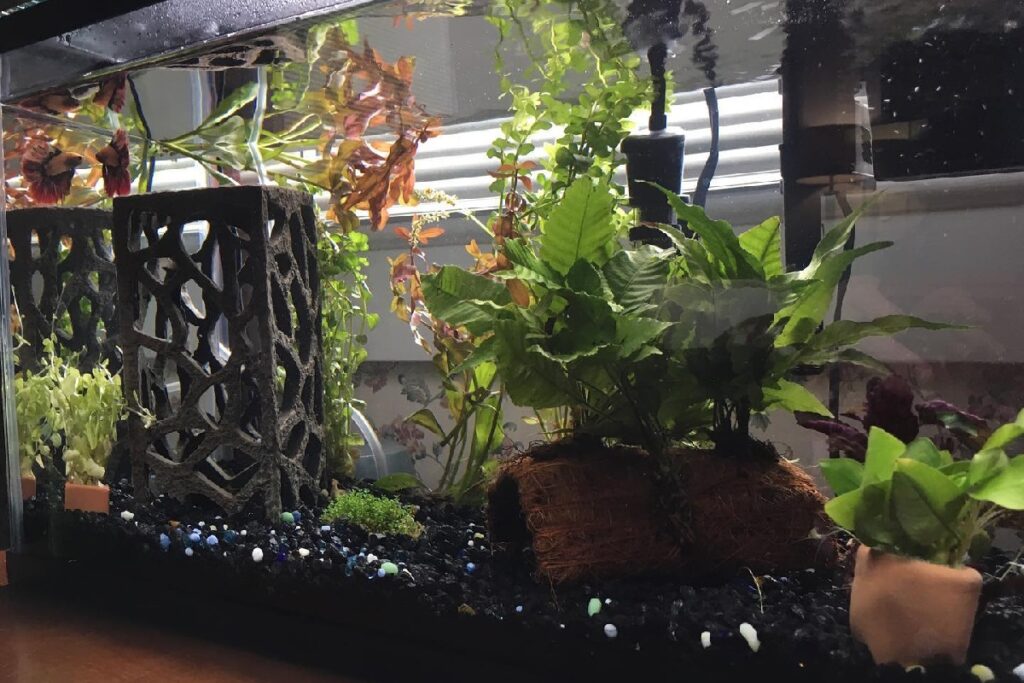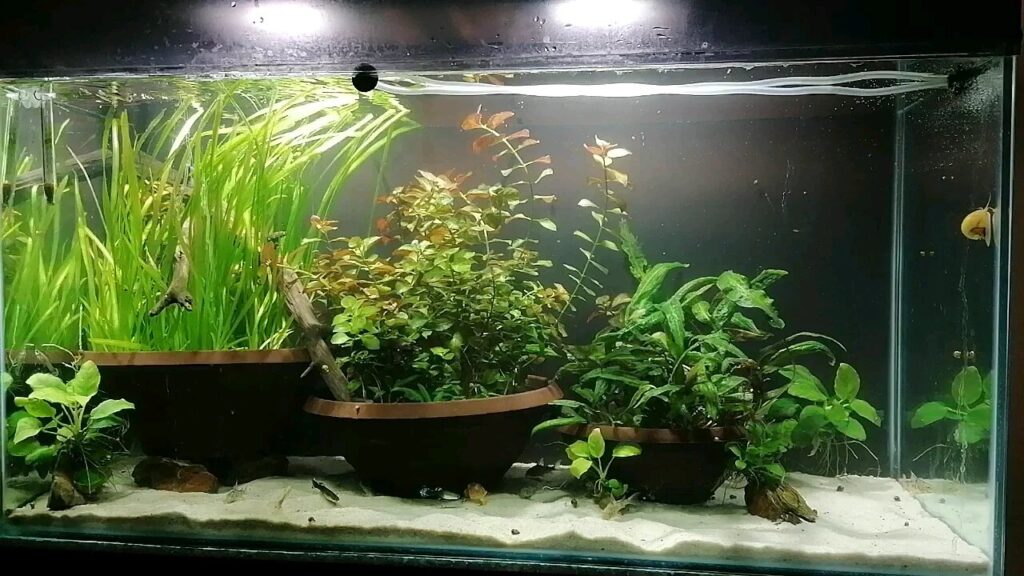Aquariums are a wonderful way to bring life and color into your home. For those just starting out with an aquarium, the thought of leaving plants in pots may seem daunting. But fear not! With proper care and maintenance, you can ensure that your aquarium plants stay safe and secure in their pots for years to come.
In this article, we’ll explore how to properly leave your aquarium plants in pots and provide tips on what supplies you’ll need to keep them healthy. We’ll also discuss the advantages of leaving plants in pots versus planting them directly into gravel or substrate within the tank. By the end of this article, you will be confident about keeping beautiful aquatic vegetation in their pot homes for maximum enjoyment.

Contents
Can You Leave Aquarium Plants In Pots?
Yes, you can leave aquarium plants in pots. This is a great way to add some greenery and decoration to your tank without having the hassle of planting them directly into the substrate. Aquarium plants are typically sold with their root system already established inside a potting material like gravel or clay pellets. Keeping them this way allows for easy maintenance as they will remain in one place, reducing the need for any frequent repositioning or replanting.
When leaving aquarium plants in pots, it’s important that you provide adequate space between each plant so there is no overcrowding occurring. You should also ensure the water current flow does not disturb too much of the soil from within the pot as this could lead to nutrient deficiency and an unhealthy environment for the aquatic life in your tank. Keeping these points in mind should ensure that your aquarium stays healthy and thriving for years to come.
What Types Of Aquarium Pots Are Safe To Use?
After considering whether aquarium plants can be left in pots, it is also important to consider what types of pots are safe for use. When choosing an aquarium pot, the materials should be considered carefully as some may pose a risk to both the fish and plant life within the tank.
The two main options for aquariums are plastic or ceramic pots. Plastic containers generally tend to be cheaper than their ceramic counterparts. However, they should only be used if specifically designed for aquatic environments. This is because regular plastic containers could leech chemicals into the water that can harm your fish and other inhabitants. Ceramic pots on the other hand provide more stability but are heavier and more expensive than plastic ones.
When selecting either option, make sure that all edges are smooth so there’s no chance of scraping or cutting any delicate fins or bodies – this applies especially to smaller tanks with larger plants as movement will create turbulence that can disturb them. Additionally, look out for drainage holes at the bottom as these will allow excess water to drain away without flooding your tank’s substrate or displacing its inhabitants. Finally, ensure that whatever type you choose has adequate ventilation so oxygen levels remain stable and healthy for those living inside it.
How Big Should My Aquarium Plant Pot Be?
Having a suitable pot for your aquarium plants is imperative to their success. Pots that are too small will not be able to provide enough nutrients, while pots that are too large can cause the plant’s roots to become soggy and rot away. With this in mind, it’s important to consider how big your aquarium plant pot should be.
The size of your aquarium plant pot should depend on the size of the root system, as well as its soil requirements. If you’re growing aquatic plants with larger root systems, such as Anubias or Echinodorus species, then opting for a bigger pot is advisable – think about 5 gallons or more for each individual specimen. On the other hand, if you’re looking at smaller rooted specimens like Cryptocoryne wendtii and Staurogyne repens, they’ll only need something between 2-3 gallons per plant. Additionally, many aquatic plants prefer acidic soils which require a wider base than regular planting media.
How To Plant Aquarium Plants In Pots

Planting aquarium plants in pots is a great way to keep your tank looking vibrant and healthy. It’s also an excellent method for controlling the spread of some aquatic plant species that can take over tanks if left unchecked. With just a few simple steps, you can successfully pot your aquarium plants and begin creating beautiful aquascapes.
The first step to planting aquarium plants in pots is selecting the right type of container. You should pick one that has plenty of drainage holes as this will allow excess water to escape while keeping soil securely inside the pot. Once you have chosen the perfect vessel, fill it with substrates such as gravel or sand and top it off with nutrient-rich soil. After adding enough water to moisten the mixture, gently dig small depressions into which you can place individual specimens or bunches of aquarium plants. Be sure to cover the roots completely before lightly pressing down on the surface to ensure everything stays secure.
With these easy guidelines, you now know how to effectively plant aquarium plants in pots! In no time at all, you’ll be able to enjoy lush vegetation growing throughout your tank – providing not only aesthetics but added oxygenation benefits for fish and other inhabitants too!
How To Put Pots In The Aquarium
When it comes to aquariums, plants are an important part of the setup. Not only do they provide oxygen for your fish, but they also add a unique aesthetic that makes your tank even more beautiful. So if you’re looking for a way to keep your aquatic plants in place, consider using pots! Here’s how:
- Get yourself some plastic or ceramic pots with good drainage holes and enough space inside to accommodate the roots of the plant.
- Line the base of the pot with gravel before adding soil or substrate mixed with fertilizers that will promote the healthy growth of your aquatic plants.
- Place each plant carefully into its own individual pot and fill it up with water until it is about half full; make sure not to overfill as this could damage the roots.
- Securely attach each pot to something like a slate rock or piece of driftwood so that it won’t move around too much when submerged in the aquarium.
- Finally, ensure that all areas around and underneath each pot have been thoroughly cleaned before submerging them – this will help prevent any bacteria from entering your tank.
It’s really quite simple once you get started – just remember to take care with every step along the way and soon enough you’ll have a thriving garden right there within your aquarium!
Conclusion
Yes, aquarium plants can be left in pots. Just make sure the pot you use is safe for your aquarium and that it’s big enough to accommodate the size of your plant. Once planted, place the pot securely inside the tank so that it won’t float or tip over. With proper care, these planted pots will flourish and provide a beautiful environment for aquatic life.
If you’re looking to add some greenery to your aquarium but don’t want to commit to planting directly into substrate, then consider keeping your plants in pots! It’s an easy solution that’ll give you all the benefits of having live plants without any extra hassle.
